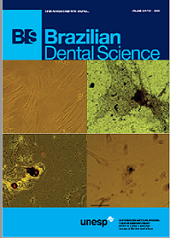Analysis of adhesive bond strength under simulated pulpal pressure on different dentin thicknesses
DOI:
https://doi.org/10.14295/bds.2020.v23i1.1858Abstract
Objective: Evaluate the microtensile bond strength (µTBS) in different dentin thicknesses, under simulated pulpal pressure (SPP), submitted to an adhesive technique using laser irradiation. Material and methods: Forty sound human molars were sectioned and randomly divided into two groups (n=20): Group 1 – 1 mm of dentin thickness; Group 2 – 2 mm of dentin thickness. Each group was divided into two subgroups (n=10): Subgroup A – Absence of SPP; Subgroup P – Presence of SPP (15 cm H2O). The samples were sequentially treated with: 37% phosphoric acid, adhesive system (Adper Single Bond 2), Nd:YAG laser irradiation (60 s, 1064 nm, 10 Hz) using 60 and 100 mJ/pulse energy parameters and photopolymerization (10 s). A composite resin block (Filtek Z350) was built up onto the irradiated area. After 30 days stored in water, the samples were sectioned and submitted to microtensile test (10 kgf load cell, 0.5mm/min). Data were analyzed by three-way ANOVA and Tukey tests. Results: Three-way ANOVA revealed no significant differences for SPP (p=0.0821) and for dentin thickness p= 0.9405) on bond strength. The laser energy parameters (p=0.001) indicated that 100 mJ showed greater µTBS means compared to the group irradiated with 60 mJ. Dentin thickness did not affect on µTBS. The presence of SPP reduced the mean µTBS values. Conclusions: Simulated pulpal pressure did not affect the µTBS using 60 mJ of laser energy parameter. At 100 mJ, the presence of SPP negatively influenced the bond strength, regardless of dentin thickness.
KEYWORDS
Bond strength; Dentin; Intrapulpal pressure; Nd:YAG laser.
Downloads
Downloads
Published
How to Cite
Issue
Section
License
Brazilian Dental Science uses the Creative Commons (CC-BY 4.0) license, thus preserving the integrity of articles in an open access environment. The journal allows the author to retain publishing rights without restrictions.
=================




























